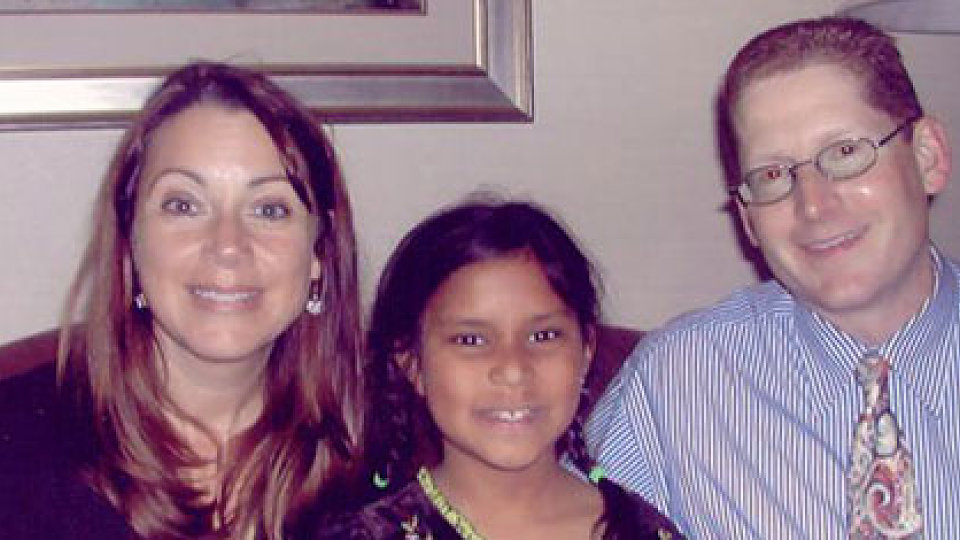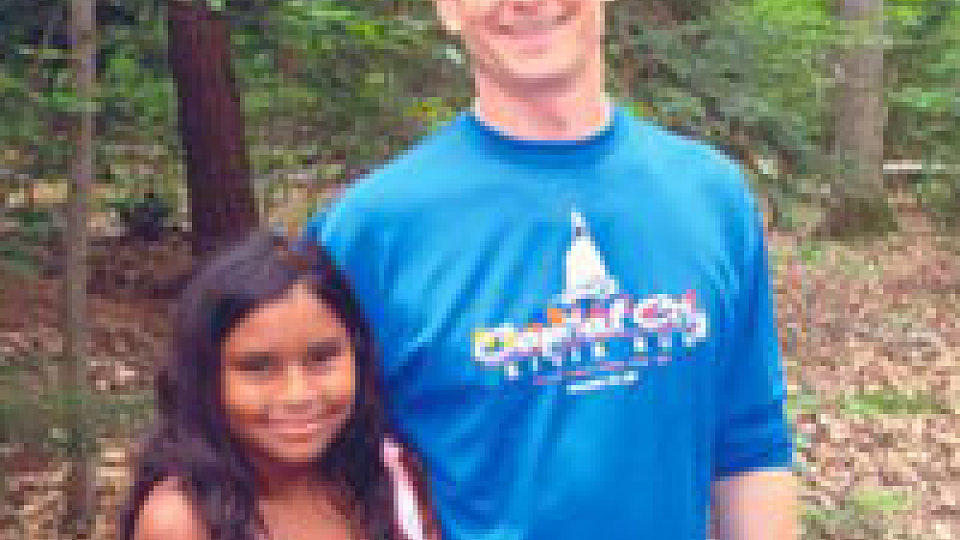Finding Tess
In the blue of the pool, between waves and the tiled bottom, I’ve lost her. My daughter’s missing in the chaos of churning chlorine. Arms, legs, heads all thrashing and bobbing, and her’s indistinguishable from the rest. Finally, I spot her, her hair thick points of streaming water as she climbs the ladder out of the deep end and moves toward the diving board.
“Tess, I’ve been looking for you, honey,” and as I touch her arm, cool and wet, the face that meets mine isn’t my daughter’s after all. “Sorry,” I say, realizing my mistake and returning my gaze to the pool. “Mom, I’m over here,” I hear from the shallow end. And there she is, her polka-dot suit a standout. She is laughing. “You did it again, didn’t you?” she asks and I nod, embarrassed, because I do this once a year, every year. Lose my daughter. And the thought of it makes us both laugh. We live in a Big Ten university town. There is diversity, but when we are out as a family at a park or pool, I can usually find Tess. She’s the one shaped like scissors, long legs stretching her into adolescence. She’s the one with hair the color of coffee, skin a softened caramel, the girl who runs with a lightness I can’t match or understand. She’s easy to spot in the current of blond and brown hair catching the water and floating.
But here today, at India Camp in Tulsa, she’s suddenly “every girl” and my husband and I are the “different ones.” She loves it. She points out to us that we look so one-of-these-things-is-not-like-the-other. “I like my brown better,” she says, and I’m oh so glad she feels that way. When Tess was little, we thought we wanted to be colorblind. After all, we didn’t think about our differences, we just noticed our similarities, our unmitigated love for each other. But we don’t look alike, and the rest of the world sees that and stares. Instead our differences have become something we acknowledge and celebrate. On our two-day car ride to Tulsa she said, “I can’t wait to be with my people.” When I asked what she meant, she laughed. “You know. Other adopted Indian kids. Not just Indians like our friends.”
“I’m the only kid in my whole school who’s from India,” she announced after her first week in kindergarten. We had enrolled her in our neighborhood elementary where there was diversity but not Indian diversity, and she noticed. So when we moved her to an elementary that resembled the UN, she loved it. Came home daily with updates of classmates—Afghanistan through Zimbabwe—who were her new friends. But then the adoption questions began. Kids who were unfamiliar with it, whose cultures kept adoption hush-hush, were intrigued and sometimes rude. One night, after our bedtime ritual of Tell Me Three Dreams, her lips trembled and she began to cry. And as most deep heart secret stories do, this one seeped out of her. She had been asked every day, “Where’s your real mom? How come your real mom gave you away? Are you happy living with those people instead of in India with your real mom?” and was frustrated. “I’m tired of kids asking me every day about adoption. So-and-so follows me around and says she feels sorry for me that I’m adopted and that you are my parents. She makes fun of me, Mom, and you and Dad, too. She’s so mean.” I told Tess I was sorry and asked her what she wanted me to do. “Will you come in and talk to the class, like you did at my other school?” And I realized my mistake. Because her school is so diverse, I had made an assumption. An assumption that all kids, regardless of family make-up, color, size, or background would be accepted in this diverse environment. I had mistakenly equated diversity with understanding.
Armed with books, handouts, information from past Dillon heritage/adoption camps, and food, I made an adoption presentation to her class the next week. The props were great, but the dialogue was the best part. Tess’s classmates asked open questions and I gave what I hoped were open answers. Then at home we practiced W.I.S.E. Up (the program by Marilyn Schoettle) again and again. Suddenly, what she had learned at Dillon’s camp and practiced at camp had a real world application. I discovered that for Tess, Walk Away was the most difficult aspect of W.I.S.E. Up. Giving my daughter permission to walk away and choose not to answer an intrusive question was powerful. It worked. School once again became what she wanted and needed.
That experience led me to reflect on so many conversations over the years at India Camp. When our girls were little we talked about adoption issues in general terms, how to handle racism, answering birthparent questions, etc. But now my husband and I have different questions, pose different scenarios to our friends who have also adopted. Will Indian boys consider dating our daughter who, at first glance is all things India, but who doesn’t speak Hindi? Who knows how to make dal and loves palak paneer but lives with parents whose ancestry ties them to the Emerald Isle? How to give our daughter at least a little experience of India while living outside of it?
Which is where the India Association of Greater Tulsa comes in to wrap its arms around our children. Volunteers teach history, language, and culture to our kids every year during camp. They feed our kids, dress them in traditional attire, teach them Bharatanatyam and encourage all of our families to learn as much about India as possible. Tess looks forward to seeing her camper friends each year and the teen girls who volunteer from the IAGT. This year, two teens are teaching our kids a Bollywood-style number that has the children enthralled. Tess is talking about it constantly, recalling her own Bharatanatyam lessons and saying she might want to take those lessons again. She hangs on the teens’ arms and words. Tess asks for jewelry like theirs, and saris, too. We parents are so grateful—grateful for this little bit of India in Tulsa.
My husband and I realize we have used the camp experiences throughout the year, every year, for six years. The panel discussions, the voicing of our deepest fears and worries, and the sacred shared experience of adoption have influenced what we do and how we do it during the rest of the year. We feel fortunate to have the support of other parents who are trying to figure it out just as we are, but Tess has been the real winner, the beneficiary of India Camp and the India Assoc. of Greater Tulsa. The good girl. Rule follower. Obedient. Cautious. Our daughter sometimes fades to wallpaper in her classroom. She’s the girl who raises a hand no one sees. Who comes home hungry from school because she didn’t have the courage to tell the lunch lady who was scolding the kids to “hurry up and eat and get outside” that she had just gotten her food and needed more time to eat it. But India Camp is helping to change that—turning some of the hesitancy into determination and confidence. I’m proud as I watch her swimming with her friends, engaged and engaging. Tomorrow I’ll cry when she takes the stage at our camp’s closing ceremony, confidently reading her part and then singing another. India Camp has taught her a love for the stage. The simple ten-minute skits each year have given her a feel for an audience, a chance to be her authentic self—artsy and happy. They’ve also given her the confidence to play a leading role in two school plays and the grace to admit defeat when she tried out for a solo. “I’m so happy for Karen, Mom. She sang way better than I did.” Yes, an opportunity to know who she really is inside out and outside in.
Earlier today she stood poised to jump from the high dive, and then, overcome with fear, she froze. I stood helplessly at the lip of the pool as the lifeguards told her she had to jump, couldn’t back down the ladder to the safety of my arms. She had no choice. As one lifeguard swam out and paddled in glinting water below the board, parents from around the pool shouted their encouragement. “You can do it!” “It’s okay, you’ll be safe.” “The lifeguards are here for you.” Tess’s eyes were on mine and it seemed like forever and ever amen passed before, crying, she stepped off the edge. As she bobbed to the surface, parents and children cheered and clapped. Campers immediately came to her as she climbed from the pool and into my hug. They offered her their congratulations and their own stories of being scared. I struggled to keep from crying because this little community of families was so supportive, so kind. And I knew she would be safe. That we would catch each other’s children, help each other’s kids figure out how to negotiate not just the pool but life. And not just life, but life as adopted children and adoptive families.
An educator and freelance writer, M. Charette lives in Michigan with her husband and daughter.






Comments